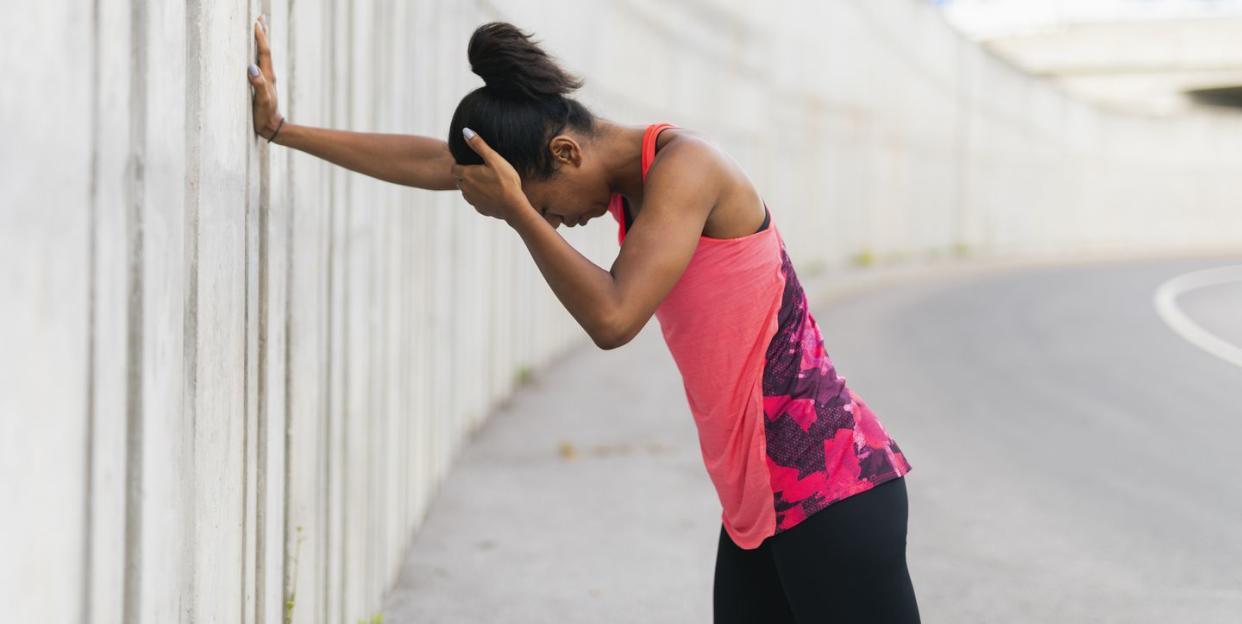The Real Reason Your Head Always Hurts After A Workout

If sometime between crushing your deadlifts and beasting your HIIT intervals, your head is totally pounding, you’re not the only one. Exercise headaches are more common than you might think. And, according to Ilan Danan, MD, MSc, a sports neurologist at the Center for Sports Neurology and Pain Medicine at Cedars-Sinai Kerlan-Jobe Institute, you can do something about them.
What is an exercise headache?
“It’s pretty much exactly what it sounds like,” says Dr. Danan. “It’s a headache that comes on during or after high-intensity exercise.” You’ll feel these headaches throughout your entire head, unlike migraines which stick to one side. And unlike regular ol' headaches, exercise headaches tend to throb. There are two types of exercise headaches: primary and secondary. Primary exercises headaches typically last anywhere between five minutes and 48 hours, while secondary can last a bit longer and are more severe.
What causes an exercise headache?
Strenuous exercise is the most common cause, says Dr. Danan. And while any type of exercise could bring on a headache, “high-intensity weight lifting might predispose you a bit more, than say, your run or your jog or bike ride” since they're more aerobic, he explains.
Other causes and risk-factors include changes in altitude, dehydration, heat, humidity, and low-blood sugar. But most of the time it’s because you're working too hard.
That said, the headaches don't mean you need to nix these workouts entirely. But in some rare cases, exercises headaches can be more severe and qualify as secondary headaches.
So...what's a secondary exercise headache?
While primary exercise headaches like this are benign and more common, it's important to note that secondary ones may point to severe underlying issues, such as a hemorrhage.
How do you know the difference? Dr. Danan says if your exercise headache started during or after a workout but persists upwards of 48 hours, it's important to take note. Or if you experience symptoms like vomiting, weakness, blurry or double vision, neck stiffness, and loss of consciousness-all in combination with a severe headache-you may have a secondary exercise headache.
Essentially, in this case, your workout brought up your blood pressure so much that it could have paved the way for more severe issues. If this happens, you'll need to see a doctor or even go to the emergency room.
What can you do to treat it?
While secondary headaches warrant a trip to the doctor, primary exercise-induced headaches are usually self-resolving. But if you're dealing with headaches, after ruling out any illnesses, Dr. Danan says taking an anti-inflammatory-whether it's over-the-counter or prescription-30 minutes before your workout could help decrease the risk.
If you're going for an over-the-counter drug, try something anti-steroidal such as Advil or Aleve, rather than Tylenol, says Dr. Danan. And when it comes to prescription-grade anti-inflammatories, he says one called indomethacin is especially effective in treating headaches.
However, if you work out most days (say, five time per week), it’s worth considering environmental causes and monitoring the weather rather than taking Advil daily. For example, if you're a sprinter who just moved from a flat area to a more mountainous one, altitude might be the cause. Or, if you run at high noon, the sun might be causing speedier dehydration, and more water could be the solution.
By taking these conditions into account, you might be able to scale back on medication, which Dr. Danan is all for.
How can you prevent exercise headaches?
If you’re prone to exercise-induced headaches, Dr. Danan says that the best move, other than taking anti-inflammatory medications, is making sure you warm up and ease your way into the workout. This is especially helpful for when headaches are brought on by environmental elements outside your control.
Some people think anti-inflammatory diets help, too, but this isn’t guaranteed. Dr. Danan doesn’t reject the idea altogether, and says if it works for you, go for it. Otherwise, drink water before you sweat, eat a balanced meal, load up on electrolytes, consider the humidity and heat before you work out outdoors, and scale back the intensity as needed.
('You Might Also Like',)
